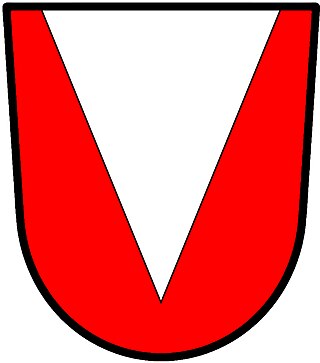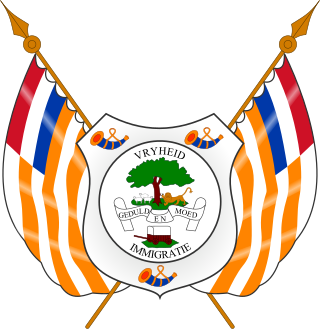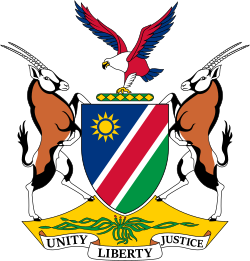
The coat of arms of the state of New York was formally adopted in 1778, and appears as a component of the state's flag and seal.

The coat of arms of Saskatchewan, officially known as His Majesty's Arms in right of Saskatchewan, is the heraldic symbol representing the Canadian province of Saskatchewan.

The coat of arms of Nunavut was granted by a warrant of Roméo LeBlanc, Governor General of Canada, dated 31 March 1999, one day before the territory of Nunavut, Canada, was created. The same document specified the flag of Nunavut.

The lines in heraldry used to divide and vary fields and charges are by default straight, but may have many different shapes. Care must be taken to distinguish these types of lines from the use of lines as charges, and to distinguish these shapes from actual charges, such as "a mount [or triple mount] in base," or, particularly in German heraldry, different kinds of embattled from castle walls.
In heraldry, variations of the field are any of a number of ways that a field may be covered with a pattern, rather than a flat tincture or a simple division of the field.
In heraldry, an ordinary is one of the two main types of charges, beside the mobile charges. An ordinary is a simple geometrical figure, bounded by straight lines and running from side to side or top to bottom of the shield. There are also some geometric charges known as subordinaries, which have been given lesser status by some heraldic writers, though most have been in use as long as the traditional ordinaries. Diminutives of ordinaries and some subordinaries are charges of the same shape, though thinner. Most of the ordinaries are theoretically said to occupy one-third of the shield; but this is rarely observed in practice, except when the ordinary is the only charge.

The coat of arms of Toronto is a heraldic symbol used to represent the city Toronto. Designed by Robert Watt, the Chief Herald of Canada at the time, for the City of Toronto after its amalgamation in 1998. The arms were granted by the Canadian Heraldic Authority on 11 January 1999.

The coat of arms of Zimbabwe was adopted on 21 September 1981, one year and five months after the national flag was adopted. Previously the coat of arms of Zimbabwe was identical to the former coat of arms of Rhodesia.

The coat of arms of the Cape Colony was the official heraldic symbol of the Cape Colony as a British colony from 1875 to 1910, and as a province of South Africa from 1910 to 1994.

The coat of arms of Cape Town is the traditional symbol of the municipality of Cape Town. The original arms from the 20th century are no longer in official use, though no new arms have yet been adopted.

The coat of arms of the Western Cape is the official heraldic symbol of the Western Cape province of the Republic of South Africa. It has been in use since 1998.
In heraldry and heraldic vexillology, a blazon is a formal description of a coat of arms, flag or similar emblem, from which the reader can reconstruct the appropriate image. The verb to blazon means to create such a description. The visual depiction of a coat of arms or flag has traditionally had considerable latitude in design, but a verbal blazon specifies the essentially distinctive elements. A coat of arms or flag is therefore primarily defined not by a picture but rather by the wording of its blazon. Blazon is also the specialized language in which a blazon is written, and, as a verb, the act of writing such a description. Blazonry is the art, craft or practice of creating a blazon. The language employed in blazonry has its own vocabulary, grammar and syntax, which becomes essential for comprehension when blazoning a complex coat of arms.

The coat of arms of the Azores is nine gold stars superimposed on a red bordure, representing the nine islands of the archipelago. The bordure surrounds a silver shield on which a blue goshawk is displayed with wings elevated and with red feet, beak, and tongue. The crest is a closed helm in gold lined with red, surmounted by a wreath and mantling of silver and blue, topped by another blue eagle on which are superimposed the same nine gold stars.

The coat of arms of Burnaby was granted originally to the Corporation of the District of Burnaby by the Canadian Heraldic Authority in 1991, and then reconfirmed for the city of Burnaby in 2005 as the corporation's successor. The grant included the full coat of arms as well as a flag and a badge, both derived from the arms.

In heraldry, a pile is a charge usually counted as one of the ordinaries. It consists of a wedge emerging from the upper edge of the shield and converging to a point near the base. If it touches the base, it is blazoned throughout.

The coat of arms of the Orange Free State was the official heraldic symbol of the Orange Free State as a republic from 1857 to 1902, and later, from 1937 to 1994, as a province of South Africa. It is now obsolete.

The coat of arms of the Transvaal was the official heraldic symbol of the South African Republic from 1866 to 1877 and again from 1881 to 1902, and later the symbol of the Transvaal Province from 1954 to 1994 in a simplified form. It is now obsolete.

The coat of arms of Stellaland was the official heraldic symbol of the short-lived Stellaland state in South Africa from 1883 to 1885. It was later revived as the municipal arms of Stellaland's capital, Vryburg.

The coat of arms of the London Borough of Camden were granted on 10 September 1965. The borough was formed by the merger of three former boroughs, namely the Metropolitan Borough of Hampstead, the Metropolitan Borough of Holborn and the Metropolitan Borough of St. Pancras, from whose arms elements were utilised in the arms of the new borough.

The first coat of arms of South Africa was granted to the Union of South Africa by King George V and later amended by the British College of Arms. It contained representation of the four provinces within the Union. The coat of arms was later retained by the Republic of South Africa after independence and for a period after the end of apartheid, until being retired in 2000. The 1910 coat of arms was replaced in 2000 by the current coat of arms of South Africa.





















